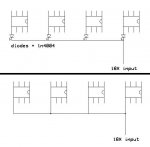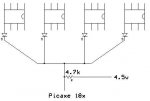I have 4 picaxe 08s that are getting data from switches and need to tell an 18x what switches are pressed, these are pushbutton switches so only one out of all 12 will be pressed at once.
because the 18x cant simultaniously wait on for different serin commands on four different inputs at once is it possible to link all of the 08 outputs together and have them connect to just one serin input on the 18x? if this is possible do I need diodes (1n4004) on all the 08 outputs?
cheers
because the 18x cant simultaniously wait on for different serin commands on four different inputs at once is it possible to link all of the 08 outputs together and have them connect to just one serin input on the 18x? if this is possible do I need diodes (1n4004) on all the 08 outputs?
cheers
Attachments
-
13.2 KB Views: 25


